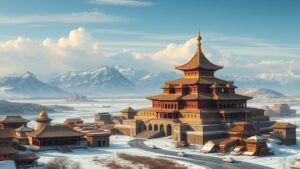Exploring tales of the lost Khmer city of Isanapura, buried in the Mekong Delta.
Exploring Tales of the Lost Khmer City of Isanapura, Buried in the Mekong Delta
The lost city of Isanapura, often shrouded in mystery and legend, offers a fascinating glimpse into the rich history of the Khmer Empire. Located somewhere in the lush Mekong Delta, Isanapura is believed to have been a bustling metropolis during its peak in the 10th century AD. As we delve into the legends and historical context surrounding this enigmatic city, we uncover not only its significant cultural contributions but also the reasons for its disappearance.
Historical Context of Isanapura
Isanapura is said to have served as an important religious and political center within the Khmer Empire, which thrived from the 9th to the 15th century. According to historical texts from the Khmer Empire, Isanapura was notably mentioned in The Chronicle of the Khmer, with speculation pointing towards its construction under Jayavarman IV. This king ruled from 928 to 941 AD and dedicated considerable efforts to expanding the empire’s territory and influence.
The name Isanapura itself is derived from the Sanskrit words Isana for northeast and pura meaning city, hinting at its geographic and cultural significance in the broader South-East Asian context. Positioned along vital trade routes, the city would have drawn merchants and travelers alike.
Archaeological Evidence and Discoveries
Despite its historical importance, concrete archaeological evidence of Isanapura remains elusive. But, numerous expeditions have sought to uncover traces of this lost city. In the 20th century, French archaeologists began unearthing ruins that some believe could be linked to Isanapura, although the true location continues to spark debate among historians.
Some of the most reputable finds include:
- Ancient temple structures, showcasing the iconic architectural style of the Khmer Empire.
- Sculpted stone remnants believed to belong to religious idols.
- Fragments of pottery and decorative items that suggest a rich cultural life.
Legends and Theories Surrounding its Disappearance
The reasons behind Isanapuras decline and ultimate disappearance are steeped in both historical accounts and folklore. Several theories have emerged, including:
- Natural Disasters: Some historians propose that flooding and changing river patterns in the Mekong Delta could have submerged the city over time.
- Political Shifts: The rise of Angkor as the primary city of the Khmer Empire may have diverted resources and attention away from Isanapura.
- Wars and Invasions: External invasions during the late 12th century may have led to its abandonment as safety became a priority for the population.
Modern-Day Exploration and Research
In recent years, technological advances in archaeology, including LiDAR (Light Detection and Ranging), have opened new avenues for discovering lost cities like Isanapura. Researchers are now able to survey and create detailed topographic maps of areas previously thought impenetrable due to dense jungles.
The importance of Isanapura continues to resonate among historians and archaeologists, who believe that its rediscovery could shed light on the complex socio-political dynamics of the Khmer Empire. Also, such findings could reveal new insights into the trade relations among ancient Southeast Asian civilizations.
Conclusion: The Legacy of Isanapura
Isanapura remains an essential piece of the puzzle when studying the history of the Khmer Empire and Southeast Asia’s rich cultural heritage. Although the city is currently lost to time, it is crucial to recognize the ongoing efforts aimed at locating its remains and understanding its significance. tales surrounding Isanapura symbolize the broader themes of discovery and preservation that characterize archaeological endeavors.
For travelers and historians alike, the search for Isanapura is not just a quest to find a lost city; it embodies a desire to connect with the past and appreciate the intricate tapestry of human history that continues to inspire future generations.


